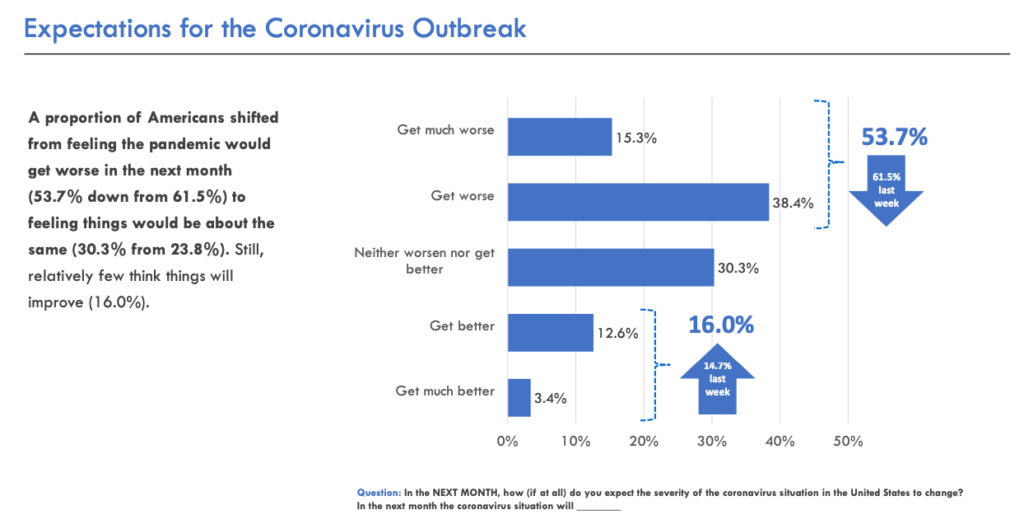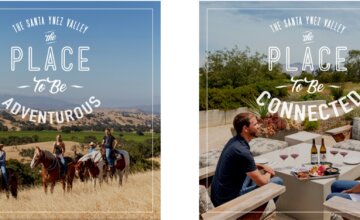DMO Insights – August 5
- Aug 04, 2020
- By Justin Yax
- In DESTINATION, DMO INSIGHTS
If you read one thing this week (other than this newsletter, of course), please take the time to pore over Destination Analysts’ in-depth findings related to COVID-19’s Impact on American Travel (link available in the Useful Links section below). It’s full of a ton of current and historical data from their research, including how we feel about travel, the pandemic’s continued impact on travel plans, travel states of mind, those traveling in 2020 vs. those not, school reopening, and the pandemic at home. Now on to this week’s news…
In this edition:
- – LATEST RESEARCH FINDINGS FROM DESTINATION ANALYSTS
- – RETHINKING THE LARGE EVENTS STRATEGY
- – FALL FAMILY TRAVEL POISED TO SURGE
- – ARE 250,000 BIKERS REALLY HEADING TO STURGIS THIS FRIDAY?
- – RECENT NEWS & USEFUL LINKS
I went back through some old emails and found one from March 18 – the earliest days of the pandemic – in which my partners and I discussed the notion that “the work we are doing right now is some of the most important work we will ever do.”
For many destinations, there are just too many moving parts for them to navigate alone right now, particularly at a time when every move is carefully orchestrated, closely scrutinized, and critically important.
As an agency that specializes in helping destinations thrive, we take great pride in our work and the close relationships we have been fortunate to build with clients over the years. And while the work we do is important on any given day, it’s our ability to provide sound strategic guidance, act as a careful steward of resources, and serve as a trusted partner that is equal parts cheerleader and adviser, that provides the most value particularly during times like this.
It’s a testament to the team we have slowly but deliberately built, and it’s why we are proud to say that at a time when many agencies are reducing staff or disbanding altogether, our public relations team grew by 50% this week with the addition of a third PR account manager, Nina Braga. Some of you may already know Nina, as she spent the last decade as the director of public relations and communications at the Four Seasons Resort Jackson Hole. It’s a position that took us six months to fill, certainly not due to a lack of interest, but because of the deliberate approach we take to the work we do and the people who do it.
Growth during a time of widespread contraction can be a scary thing. It can also provide reassurance and validation that what you’re doing is, in fact, demonstrating value, being well-received, and making a meaningful difference when it is needed most.
Thanks, as always, for reading, and we hope you continue to find value in this newsletter. If there is a particular topic that you’d like us to explore in-depth, please drop me a note at justin@dvaadv.com and we’ll be sure to work it into an upcoming issue.
LATEST RESEARCH FINDINGS FROM DESTINATION ANALYSTS
It’s starting to feel a little bit like Groundhog Day in this week’s survey findings from Destination Analysts (PDF available HERE), as we relive some of the same sentiments from travelers and residents that we saw more than a month ago.
Optimism among travelers is increasing, but so too are the anti-tourism cries among residents. Stay tuned, as we could be on a collision course if travel activity picks up further in the coming months, and locals dig in their heels in defense of their community’s health and safety.
We’re already seeing signs of this in several destinations, and plan to dive deeper into the topic in next week’s DMO Insights.
Stuck in a holding pattern: People’s concerns that the pandemic will get worse over the next month improved 7.8% this week, with 53.7% now saying it will get worse or much worse, down from 61.5% last week. At the same time, the number of people who think the situation will stay the same increased 6.5% to 30.3%. Only 16% believe the situation will get better or much better in the next month, up slightly from 14.7% last week. This would indicate that while a decreasing number of respondents think things will get worse, they aren’t getting much better, either.

Locals still wary of tourism messaging: Not surprisingly, the number of locals who would be “unhappy” or “very unhappy” with seeing a tourism ad for their own community jumped to 37.5% in July, an increase of 6.2% from June. At the same time, the number of people who said they would be “happy” or “very happy” seeing one dropped to 29.1% in July, down from 35.8% in June. Further evidence that the moral dilemma of tourism during a pandemic that we discussed in the July 21 newsletter is still very much real and relevant.
If school’s out, travel is in: As we discuss in greater detail below, the increasing likelihood that many schools will not reopen in the fall has parents scrambling to make plans. Among those plans, 34.5% of parents with school age children say they are more likely to take more family trips this fall as a result. Another 37.7% are neutral on the subject, while only 21% are less likely to take part in family travel this fall if in person school is cancelled.
Travel in 2020 is split 50/50: About half (48.5%) of respondents have at least one leisure trip planned in the remainder of 2020. The other 51.5% have no plans to travel this year. Of course these numbers will fluctuate due to cancellations, last-minute decisions to go somewhere, and short planning and booking windows that are so prevalent right now.
BACK TO TOP
RETHINKING THE LARGE EVENTS STRATEGY
With events of all shapes and sizes being postponed indefinitely or canceled outright for the remainder of 2020 and into 2021, destinations are being forced to take a difficult and honest look at their events strategy moving forward.
There is no question that the pandemic will have lasting impacts on events and will in some ways forever alter their size and success, their positive impacts on the local economy, and their priority in a destination’s marketing plan.
As the manner in which events are executed becomes more complex, and the costs associated with doing so increase, additional hurdles are encountered. That doesn’t mean there will no longer be a place for them in the strategy, but it does mean that big changes are coming to an event near you.
Looking for a silver lining among the chaos that has engulfed events, it is perhaps the fact that many of them have become complacent, stagnant, or in need of an injection of new life, direction, and purpose. Well, there’s nothing like a pandemic to give us a reason to wipe the slate clean, and plenty of time to do so.
Destination Analysts’ most recent research on the topic from July 12 gives us two primary insights into the future of events as the chart below indicates:
The first insight is that events already rank low on the list of peoples’ leisure travel priorities and are largely not considered to be a primary travel motivator. Only 24.3% of respondents listed “attending festivals & events” as being of importance or high importance to their travels. This put it near the bottom of the list of priorities, ahead of only meeting new people, attending sporting events, and bragging rights.
The second is that of all leisure travel activities, events have perhaps been hit the hardest. When asked which leisure travel priorities have been most impacted by COVID-19 for the remainder of 2020, “attending festivals & events” topped the list with 64.5% indicating that the pandemic “has significant effect or makes impossible.” The 40.2% gap between priority and probability was second only to attending sporting events (44.9%).
Knowing that events have been devastated in the short-term, will be severely impacted for at least the next year, and will likely be forever altered in some way as a result of the pandemic and future health threats, what can and should destinations be doing right now to rethink, reimagine, and pivot their events strategy? Here are a few things to consider:
Cost-benefit analysis: The first evaluation of any event should focus on the cost-benefit analysis. While some events barely break even and are used as a loss leader to attract visitors, others serve as a primary revenue source for destinations. For the foreseeable future, the costs associated with producing events – everything from staffing, security, and social distance monitoring, to health & safety checks, medical staffing, and even liability insurance – will likely increase. The question then becomes whether the investment is worth the return, or if those dollars are better utilized by being redirected toward other, more targeted efforts and initiatives to attract visitors.
Quality over quantity: Rather than packing the calendar with a weekly lineup of events from Memorial Day through Labor Day, scaling back and focusing on the quality of a select few “anchor” events over sheer quantity can be more manageable, provide a better and safer experience for attendees, and drive demand during specific timeframes. It also allows you to dedicate more marketing resources toward a handful of initiatives, as opposed to spreading them thinly across dozens.
Reservations required: There’s no question we are moving quickly toward a more reservation-based economy for everything from the obvious activities like dining and wine tasting, to less likely candidates such as outdoor recreation and possibly even grocery shopping. Shifting events – even those that are free of charge or not typically ticketed – to a reservation basis is one way that destinations can still pull off larger events in a safe and enjoyable manner. This includes going as far as requiring attendees to choose a specific block of time for their ‘reservation,’ similar to the OpenTable concept for dining. While it may limit spontaneity to a degree, it will allow for better management of crowds, increase physical distancing and overall safety, and provide valuable information for things like contact tracing should any unfortunate health concerns arise. Not to mention there are the added benefits of allowing you to better forecast and prepare for attendance, and to capture valuable contact information for future marketing efforts.
Scale back & find a niche: Look at dialing back the size and scope of events as a whole, and consider smaller, more manageable events – particularly those that target a specific niche such as nature photography, private aviation, an automobile rendezvous, or other groups who might not visit otherwise.
Off peak: While many events are already seen as a way to drive visitation during the shoulder and off seasons, that trend will only get stronger. A summer festival or event when visitation is high might not be the right strategy to attract even more people during an already busy time. Shifting popular events to the shoulder and off seasons when appropriate, or creating new events during those timeframes, however, may help bolster visitation during slower months.
Hybrid events: When people can’t (or won’t) attend in person, finding ways to give them the same or similar experience can be challenging but is another area where change is inevitable. Adding a well-produced live streaming element such as Facebook Watch or YouTube Live for iconic events can keep a destination’s awareness, sentiment, and engagement levels high.
BACK TO TOP
FALL FAMILY TRAVEL POISED TO SURGE
According to a recent announcement from the United Nations, the current global pandemic has “led to the largest disruption of education ever.” With U.S. school closures extending into fall in most states, Labor Day does not signify the ceremonial end to the travel season that it typically does.
For parents, extended school closures mean once again having to balance the demands of work, childcare, and family life. But somewhere in between remote working and online learning lies an opportunity that, as stated above in the research findings from Destination Analysts, might help fuel a fall and even winter boon for tourism.
Looking at the same chart as the previous story that weighs travel priorities versus the realities of COVID travel, many of the top criteria are well-suited to family travel this fall and beyond.
Focus on drive markets: Most travel-related decisions being made right now in general, including those that might involve planning around work schedules and online or home schooling, are being made at the last minute. The current popularity of spontaneous travel would imply that focusing family travel messaging on drive markets is the way to go.
Don’t dismiss day trips: While day trippers do nothing to line the lodging tax coffers most of us rely on, they do bring much-needed revenue to other local businesses and create a reason or incentive to return in the future.
Midweek & long weekends: With the added flexibility many of us have in our schedules right now, many families have the ability to travel midweek and visit during slower times. They also have the valuable ability to extend weekend stays by a night or two on either end.
Edu-tourism: Incorporating new or promoting existing educational elements of your destination – such as history, geology, cultural, or other subjects – can provide a real world learning experience for both children and families while breaking up the monotony of learning from home and allowing them to turn your destination into their own personal outdoor classroom for a few days.
BACK TO TOP
ARE 250,000 BIKERS REALLY HEADING TO STURGIS THIS FRIDAY?
This one seemed too crazy to pass up. The good news, I guess, is that event organizers aren’t expecting the typical 600,000 attendees when the 80th annual Sturgis Motorcycle Rally kicks off this Friday in Sturgis, South Dakota (pop. 7,000). The bad news is that they are still expecting upwards of 250,000 attendees for the 10-day festival, despite local outcry for what is being described by some as a “huge, foolish mistake.” Did I mention that the event takes place in South Dakota, one of only two states in the country that has no government mask-wearing requirements in any circumstances?
That’s a quarter of a million people descending on one corner of a state that has a total population of less than 900,000 and whose largest city, Sioux Falls, is home to less than 200,000 people. While the state only has 9,079 confirmed cases as of today, the average number of new cases per day is up 37% from two weeks ago.
According to one local Sturgis business owner, “It’s the biggest single event that’s going on in the United States that didn’t get canceled, and a lot of people think it’s going to be bigger than ever.”
The biggest concerns, which are also the biggest question marks, are just how many people are actually going to show up, whether and to what extent COVID-19 might be prevalent at the event, and how many people are going to bring the virus back home with them to their families, friends, and communities.
BACK TO TOP
RECENT NEWS & USEFUL LINKS
Recent News
School’s out: How the pandemic could change the way your family travels – The Points Guy
More than half of Americans willing to fly domestically for next vacation – Travel + Leisure
Afraid of airlines? There’s always a private jet – The New York Times
Surging tourism is straining this Yellowstone gateway town – National Geographic
The push to open schools is guaranteed to fail – The Atlantic
Useful Links
COVID-19’s Impact on American Travel – Destination Analysts
Key Survey Findings – Week of August 3 – Destination Analysts
Coronavirus and Travel: Everything You Need to Know – Conde Nast Traveler




